Abstract
Human neutrophils (PMN) express a receptor for iC3b, a cleavage product of C3b. CR3 is an important receptor for phagocytosis of opsonized bacteria and its expression is enhanced by cell activation. We examined PMN CR3 expression during phagocytosis using flow cytometry and a CR3-specific monoclonal antibody. After 30 min phagocytosis of opsonized S. aureus and E. coli, CR3 expression increased to 151% and 221% of controls, respectively. Unopsonized S. aureus had no effect on CR3; however, unopsonized E. coli enhanced CR3 expression despite not being phagocytosed. Time-kinetic studies indicated a rapid initial fall in CR3 after addition of bacteria to PMN, followed by enhanced expression within 5-10 min. The initial fall in CR3 probably represented CR3 internalization rather than receptor destruction, as superoxide dismutase, catalase and protease inhibitors had no effect on this. Correlation of CR3 expression with the PMN oxidative response, measured with the intracellular fluorescent probe DCF-DA, demonstrated a dichotomy. Opsonized S. aureus and E. coli caused an oxidative response from PMN but unopsonized E. coli, which caused significant CR3 up-regulation, did not. CR3 up-regulation with unopsonized and opsonized E. coli was markedly inhibited by Polymyxin B, suggesting a role for endotoxin. These experiments indicate that CR3 expression can be regulated during phagocytosis, and the mechanisms responsible are distinct from those involved in the oxidative burst. CR3 up-regulation following exposure to bacteria in vivo may enhance neutrophil function at sites of infection.
Full text
PDF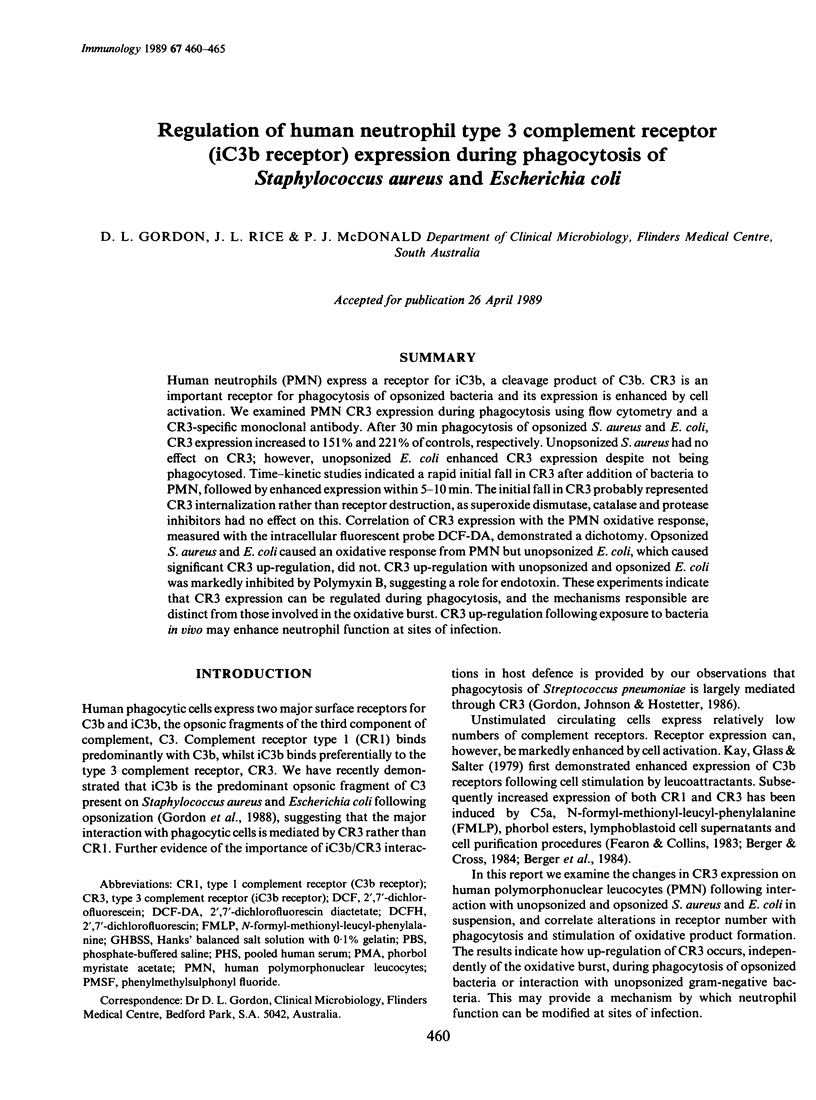
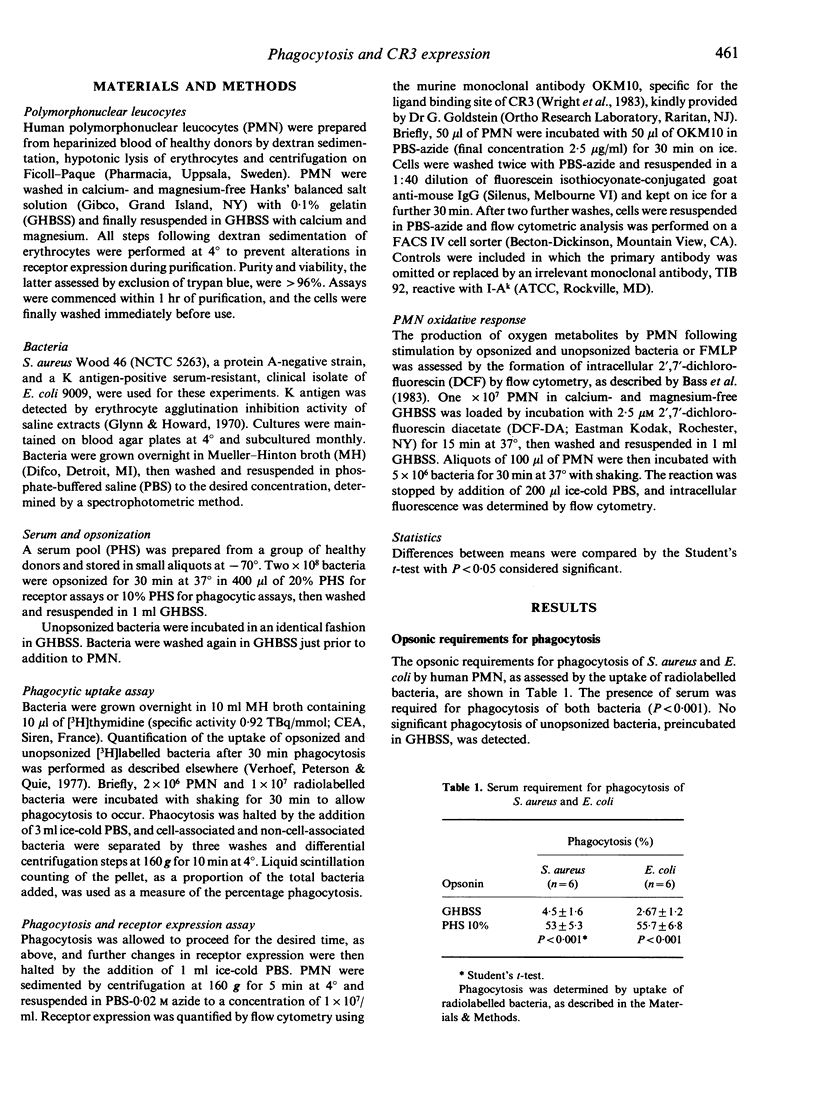
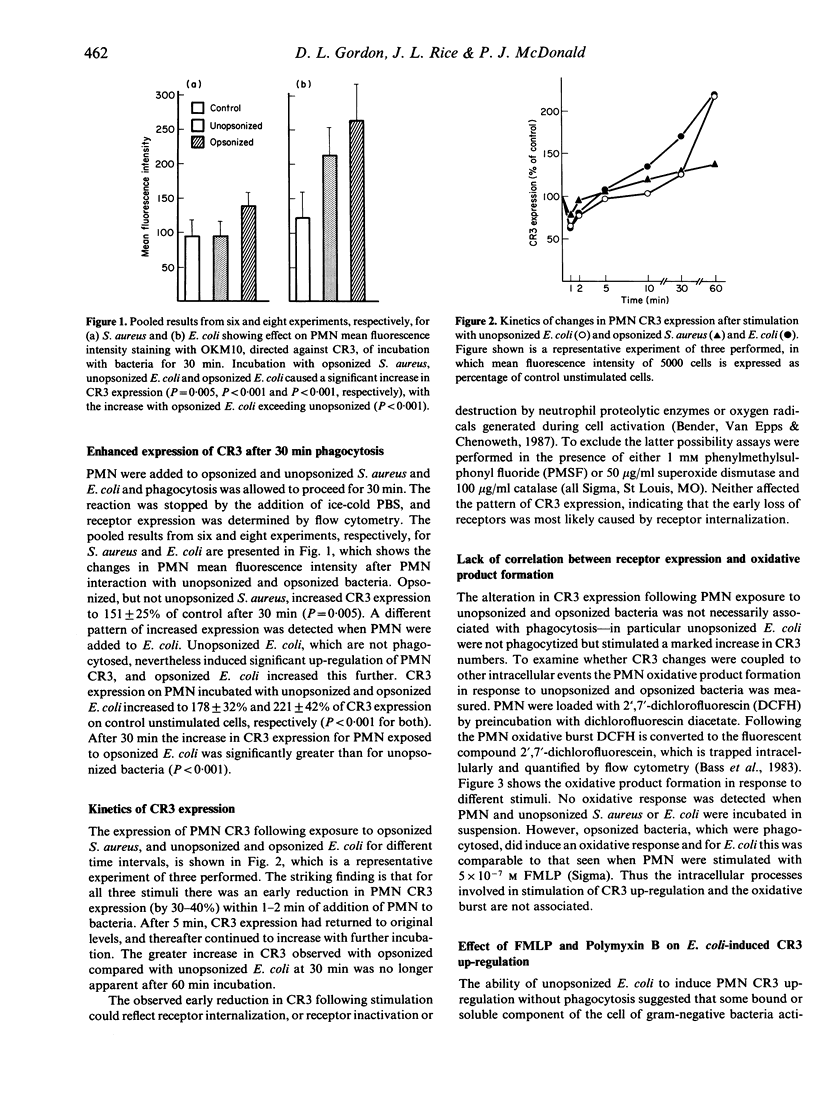
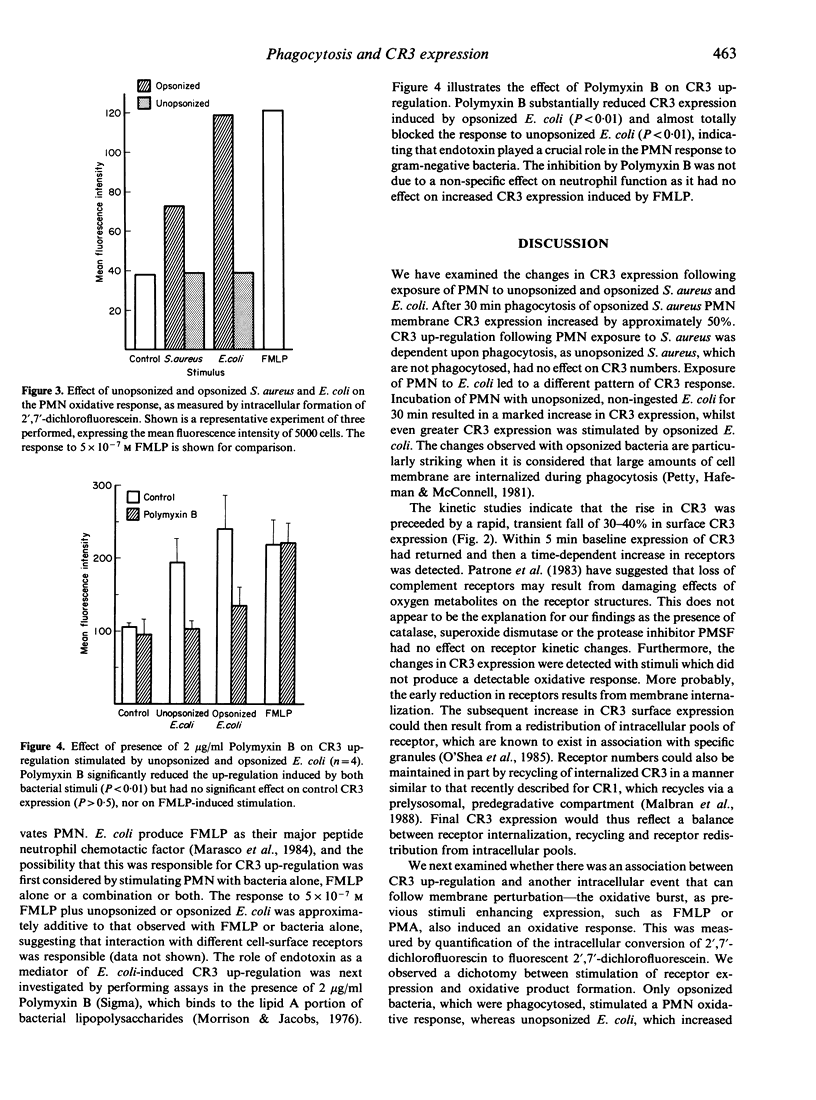
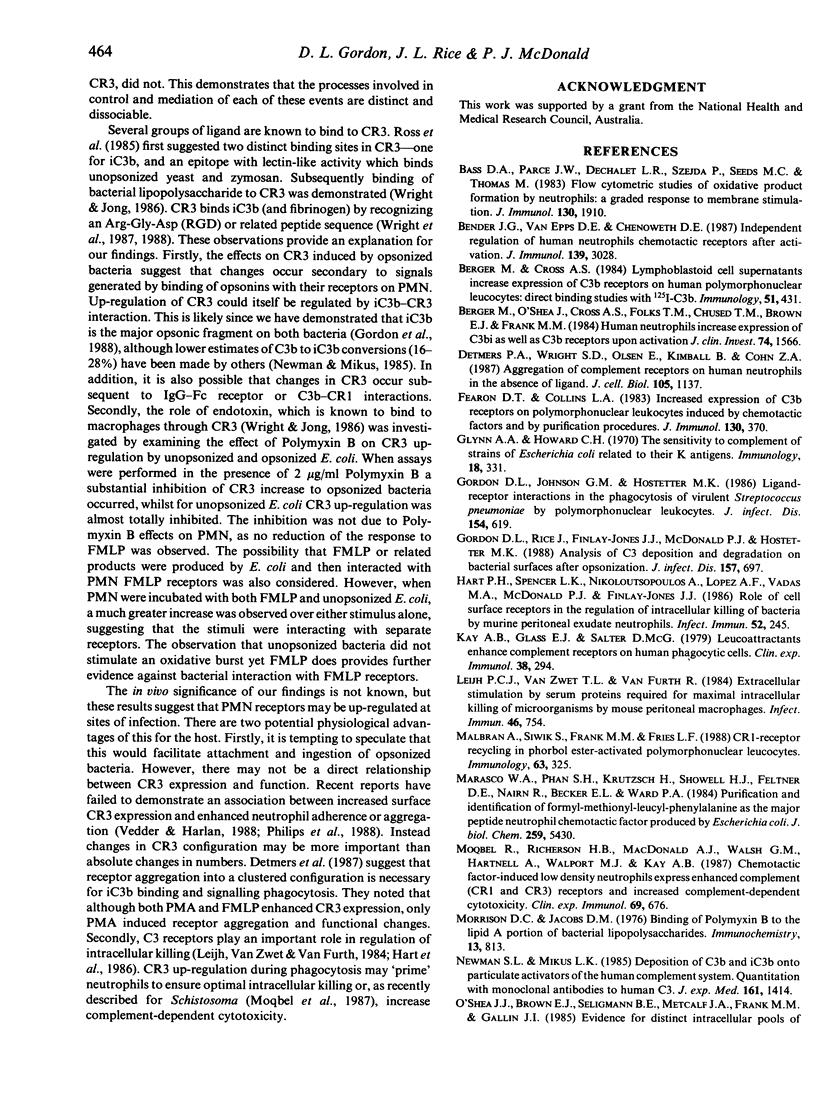
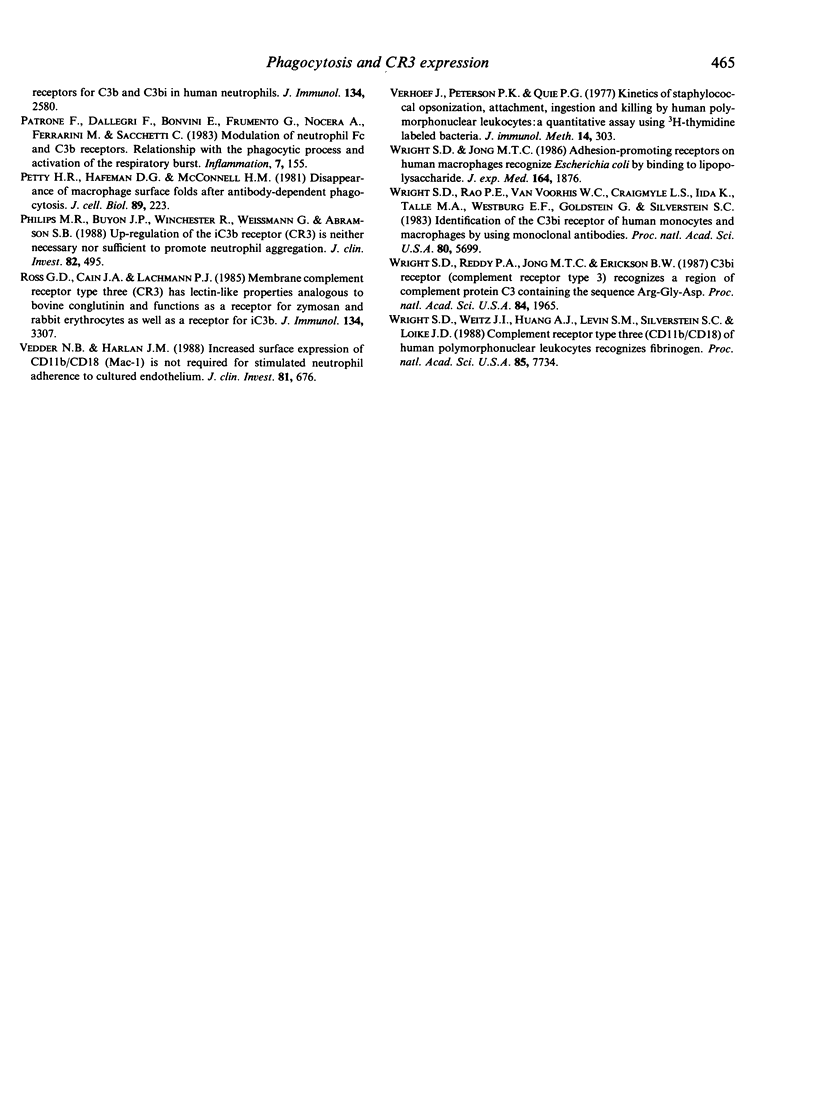
Selected References
These references are in PubMed. This may not be the complete list of references from this article.
- Bass D. A., Parce J. W., Dechatelet L. R., Szejda P., Seeds M. C., Thomas M. Flow cytometric studies of oxidative product formation by neutrophils: a graded response to membrane stimulation. J Immunol. 1983 Apr;130(4):1910–1917. [PubMed] [Google Scholar]
- Bender J. G., Van Epps D. E., Chenoweth D. E. Independent regulation of human neutrophil chemotactic receptors after activation. J Immunol. 1987 Nov 1;139(9):3028–3033. [PubMed] [Google Scholar]
- Berger M., Cross A. S. Lymphoblastoid cell supernatants increase expression of C3b receptors on human polymorphonuclear leucocytes: direct binding studies with 125I-C3b. Immunology. 1984 Mar;51(3):431–440. [PMC free article] [PubMed] [Google Scholar]
- Berger M., O'Shea J., Cross A. S., Folks T. M., Chused T. M., Brown E. J., Frank M. M. Human neutrophils increase expression of C3bi as well as C3b receptors upon activation. J Clin Invest. 1984 Nov;74(5):1566–1571. doi: 10.1172/JCI111572. [DOI] [PMC free article] [PubMed] [Google Scholar]
- Detmers P. A., Wright S. D., Olsen E., Kimball B., Cohn Z. A. Aggregation of complement receptors on human neutrophils in the absence of ligand. J Cell Biol. 1987 Sep;105(3):1137–1145. doi: 10.1083/jcb.105.3.1137. [DOI] [PMC free article] [PubMed] [Google Scholar]
- Fearon D. T., Collins L. A. Increased expression of C3b receptors on polymorphonuclear leukocytes induced by chemotactic factors and by purification procedures. J Immunol. 1983 Jan;130(1):370–375. [PubMed] [Google Scholar]
- Glynn A. A., Howard C. J. The sensitivity to complement of strains of Escherichia coli related to their K antigens. Immunology. 1970 Mar;18(3):331–346. [PMC free article] [PubMed] [Google Scholar]
- Gordon D. L., Johnson G. M., Hostetter M. K. Ligand-receptor interactions in the phagocytosis of virulent Streptococcus pneumoniae by polymorphonuclear leukocytes. J Infect Dis. 1986 Oct;154(4):619–626. doi: 10.1093/infdis/154.4.619. [DOI] [PubMed] [Google Scholar]
- Gordon D. L., Rice J., Finlay-Jones J. J., McDonald P. J., Hostetter M. K. Analysis of C3 deposition and degradation on bacterial surfaces after opsonization. J Infect Dis. 1988 Apr;157(4):697–704. doi: 10.1093/infdis/157.4.697. [DOI] [PubMed] [Google Scholar]
- Hart P. H., Spencer L. K., Nikoloutsopoulos A., Lopez A. F., Vadas M. A., McDonald P. J., Finlay-Jones J. J. Role of cell surface receptors in the regulation of intracellular killing of bacteria by murine peritoneal exudate neutrophils. Infect Immun. 1986 Apr;52(1):245–251. doi: 10.1128/iai.52.1.245-251.1986. [DOI] [PMC free article] [PubMed] [Google Scholar]
- Kay A. B., Glass E. J., Salter D. M. Leucoattractants enhance complement receptors on human phagocytic cells. Clin Exp Immunol. 1979 Nov;38(2):294–299. [PMC free article] [PubMed] [Google Scholar]
- Leijh P. C., van Zwet T. L., van Furth R. Extracellular stimulation by serum proteins required for maximal intracellular killing of microorganisms by mouse peritoneal macrophages. Infect Immun. 1984 Dec;46(3):754–758. doi: 10.1128/iai.46.3.754-758.1984. [DOI] [PMC free article] [PubMed] [Google Scholar]
- Malbran A., Siwik S., Frank M. M., Fries L. F. CR1-receptor recycling in phorbol ester-activated polymorphonuclear leucocytes. Immunology. 1988 Feb;63(2):325–330. [PMC free article] [PubMed] [Google Scholar]
- Marasco W. A., Phan S. H., Krutzsch H., Showell H. J., Feltner D. E., Nairn R., Becker E. L., Ward P. A. Purification and identification of formyl-methionyl-leucyl-phenylalanine as the major peptide neutrophil chemotactic factor produced by Escherichia coli. J Biol Chem. 1984 May 10;259(9):5430–5439. [PubMed] [Google Scholar]
- Moqbel R., Richerson H. B., MacDonald A. J., Walsh G. M., Hartnell A., Walport M. J., Kay A. B. Chemotactic factor-induced low density neutrophils express enhanced complement (CR1 and CR3) receptors and increased complement-dependent cytotoxicity. Clin Exp Immunol. 1987 Sep;69(3):676–686. [PMC free article] [PubMed] [Google Scholar]
- Morrison D. C., Jacobs D. M. Binding of polymyxin B to the lipid A portion of bacterial lipopolysaccharides. Immunochemistry. 1976 Oct;13(10):813–818. doi: 10.1016/0019-2791(76)90181-6. [DOI] [PubMed] [Google Scholar]
- Newman S. L., Mikus L. K. Deposition of C3b and iC3b onto particulate activators of the human complement system. Quantitation with monoclonal antibodies to human C3. J Exp Med. 1985 Jun 1;161(6):1414–1431. doi: 10.1084/jem.161.6.1414. [DOI] [PMC free article] [PubMed] [Google Scholar]
- O'Shea J. J., Brown E. J., Seligmann B. E., Metcalf J. A., Frank M. M., Gallin J. I. Evidence for distinct intracellular pools of receptors for C3b and C3bi in human neutrophils. J Immunol. 1985 Apr;134(4):2580–2587. [PubMed] [Google Scholar]
- Patrone F., Dallegri F., Bonvini E., Frumento G., Nocera A., Ferrarini M., Sacchetti C. Modulation of neutrophil Fc and C3b receptors. Relationship with the phagocytic process and activation of the respiratory burst. Inflammation. 1983 Jun;7(2):155–168. doi: 10.1007/BF00917820. [DOI] [PubMed] [Google Scholar]
- Petty H. R., Hafeman D. G., McConnell H. M. Disappearance of macrophage surface folds after antibody-dependent phagocytosis. J Cell Biol. 1981 May;89(2):223–229. doi: 10.1083/jcb.89.2.223. [DOI] [PMC free article] [PubMed] [Google Scholar]
- Philips M. R., Buyon J. P., Winchester R., Weissmann G., Abramson S. B. Up-regulation of the iC3b receptor (CR3) is neither necessary nor sufficient to promote neutrophil aggregation. J Clin Invest. 1988 Aug;82(2):495–501. doi: 10.1172/JCI113623. [DOI] [PMC free article] [PubMed] [Google Scholar]
- Ross G. D., Cain J. A., Lachmann P. J. Membrane complement receptor type three (CR3) has lectin-like properties analogous to bovine conglutinin as functions as a receptor for zymosan and rabbit erythrocytes as well as a receptor for iC3b. J Immunol. 1985 May;134(5):3307–3315. [PubMed] [Google Scholar]
- Vedder N. B., Harlan J. M. Increased surface expression of CD11b/CD18 (Mac-1) is not required for stimulated neutrophil adherence to cultured endothelium. J Clin Invest. 1988 Mar;81(3):676–682. doi: 10.1172/JCI113372. [DOI] [PMC free article] [PubMed] [Google Scholar]
- Verhoef J., Peterson P. K., Quie P. G. Kinetics of staphylococcal opsonization, attachment, ingestion and killing by human polymorphonuclear leukocytes: a quantitative assay using [3H]thymidine labeled bacteria. J Immunol Methods. 1977;14(3-4):303–311. doi: 10.1016/0022-1759(77)90141-7. [DOI] [PubMed] [Google Scholar]
- Wright S. D., Jong M. T. Adhesion-promoting receptors on human macrophages recognize Escherichia coli by binding to lipopolysaccharide. J Exp Med. 1986 Dec 1;164(6):1876–1888. doi: 10.1084/jem.164.6.1876. [DOI] [PMC free article] [PubMed] [Google Scholar]
- Wright S. D., Rao P. E., Van Voorhis W. C., Craigmyle L. S., Iida K., Talle M. A., Westberg E. F., Goldstein G., Silverstein S. C. Identification of the C3bi receptor of human monocytes and macrophages by using monoclonal antibodies. Proc Natl Acad Sci U S A. 1983 Sep;80(18):5699–5703. doi: 10.1073/pnas.80.18.5699. [DOI] [PMC free article] [PubMed] [Google Scholar]
- Wright S. D., Reddy P. A., Jong M. T., Erickson B. W. C3bi receptor (complement receptor type 3) recognizes a region of complement protein C3 containing the sequence Arg-Gly-Asp. Proc Natl Acad Sci U S A. 1987 Apr;84(7):1965–1968. doi: 10.1073/pnas.84.7.1965. [DOI] [PMC free article] [PubMed] [Google Scholar]
- Wright S. D., Weitz J. I., Huang A. J., Levin S. M., Silverstein S. C., Loike J. D. Complement receptor type three (CD11b/CD18) of human polymorphonuclear leukocytes recognizes fibrinogen. Proc Natl Acad Sci U S A. 1988 Oct;85(20):7734–7738. doi: 10.1073/pnas.85.20.7734. [DOI] [PMC free article] [PubMed] [Google Scholar]


